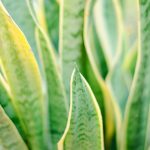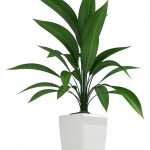Although there are a number of spider plant varieties available, they all require similar conditions to encourage optimal growth. Spider plants look fabulous in hanging baskets or positioned on a shelf where their thin, arching leaves have plenty of space to grow. The different spider plant varieties offer differences in leaf colour and size, but they will all produce the characteristic, cascading spider plant ‘babies’ that they are so well-known for.
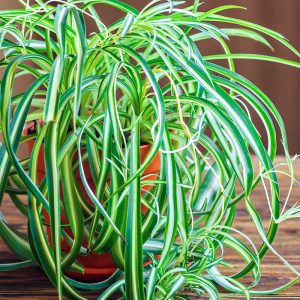
 |
 |
 |
 |
| Light | Water | Ease of Growing | Growth Rate |
| Moderate light requirements. Avoid direct sunlight. | Regular watering during the growing season, less in winter. | Very easy, great for beginners. | Very fast given the right conditions. |
All spider plants have a fountain shape growing to about 12″ (30cm) in height and width. Their length may double as the trailing spider plant ‘babies’ hang down from the main plant. These can be left in place for a couple of years or used to propagate new plants.
The more common spider plant varieties include the ‘Vittatum’ which has reverse variegated leaves with the white stripe down the centre. The ‘Variegatum’ is a broader green leaf with white stripes down the edges of the leaf and the newer ‘Bonnie’ is a little less spreading with interesting, curly leaves, again with the white stripe down the middle.
Spider plants will often flower after about a year if they are given the right conditions. Little, white flowers are to be expected in spring and summer and grow on long spikes from the centre of the plant. A plant that is slightly root bound is more like to produce flowers, and fertilizing less often will help with flower production.
Spider Plant Varieties Care Guide
Light
Spider plants are not too particular when it comes to light. They will grow in brightly light areas or in places with less light available. The important thing is to avoid direct sunlight as this can scorch the leaves. The leaves of plants grown in lower light conditions may not have such distinctive color variation as similar plants grown in brighter light. The ‘Variegatum’ is suited more to lower light because of its darker leaves.
Water
All spider plant varieties are generally thirsty during the growing season and require less water in winter. When you water your sider plant it is best to water the soil, not the plant and allow the water to soak through the pot and drain away. Don’t leave your spider plant sitting in soggy soil as this could cause root rot.
Check the top couple of inches of soil. If it feels dry when you poke your finger in, give your spider plant a good drink, but if it still moist, leave it a little longer. Spider plants can tolerate being slightly drier, especially in cooler weather. As you get to know your plant, watch for drooping leaves, a sure sign it needs a drink.
Fluoride in tap water can upset your spider plant so it is best to either water it with rainwater, distilled water or fill your watering can and leave it sitting on the bench overnight before watering your plant.
Temperature
The temperature is not particularly important to spider plant varieties, they are fairly hardy. Having said that, if the air temperature gets below 50ºF (10ºC) your spider plant might show some signs of damage. Generally, if you are comfortable in your home, they will be too.
Humidity
Again, due to their hardy nature, you really shouldn’t have any trouble with humidity as spider plant varieties can tolerate quite low humidity levels. If the humidity levels are extremely low, sitting them on a pebble tray filled with water will help.
Pruning
The only pruning that is required is to tidy up your spider plant if it has any dead or unsightly leaves. If your plant develops brown leaf tips, these can simply be trimmed off which keeps the plant looking healthy whilst it recovers.
Spider Plant Varieties Planting Guide
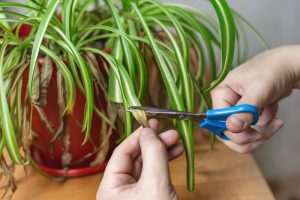
Soil
The most important thing for a spider plant is to have free-draining soil. A general purpose potting mix will be perfectly fine and if you purchase one enriched with nutrients your feeding will be taken care of as well.
Repotting
Spider plants can be repotted if their roots are growing out of the pot or if the plant has become quite root bound. The time to replant is in spring, roughly every two years. They can be repotted into the same size container, with fresh soil, or use a slightly larger pot if your spider plant is still growing
Propagation
All spider plant varieties are fun to propagate. The success rate for spider plant propagation is usually fairly high and with the large number of plantlets produced, there will be plenty of new plants to pass on to your friends or spread around your home.
There are three main ways that spider plants can be propagated. The ‘baby’ spider plants will grow small roots if they are left attached to the plant. These can be removed and either placed directly in soil or in water for an easy way to grow new plants.
Another option is to fill small pots with soil and sit them beside the main plant. The plantlets can then be placed in these pots and left attached to the plant for a couple of weeks whilst roots grow. A toothpick bent in half can be pushed over the plantlet stem and into the soil to hold the planlet in place and this will encourage the plantlet to root. After a couple of weeks the stem between the main plant and the new plant can be cut.
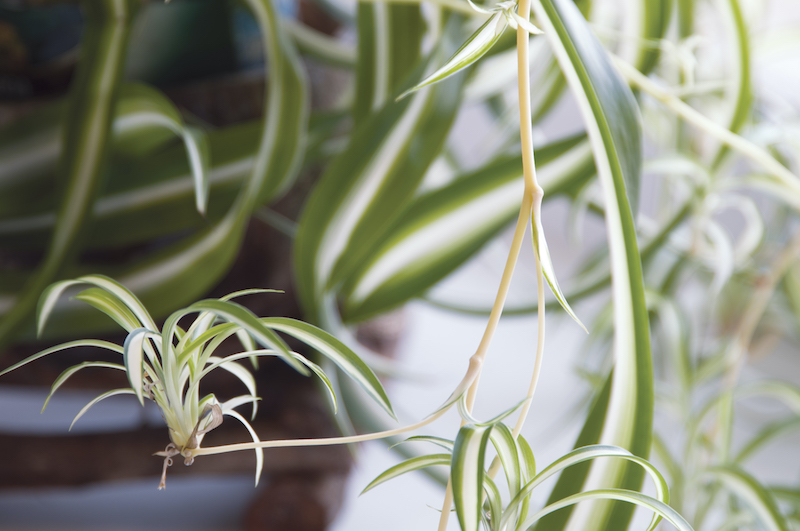
It is best to keep the soil moist for young plantlets however they don’t need fertilizer for the first year. Placing them in a brightly lit spot, out of direct sunlight will encourage new growth.
Growing in Water
The spider plant ‘babies’ that are placed in water to root can be left in water and will grow quite well. It’s best to ensure that only the roots are in water and keep the stem out of the water to avoid it rotting. Pebbles placed in the jar or a narrow-neck jar can assist with this.

Common Problems With Spider Plant Varieties
Spider plant varieties are not usually affected by insects, however they may still develop a few signs that cause concern for their owners.
Brown leaf tips can be caused by underfeeding, excessive hot air or fluoride in the water. If you have used a nutrient-enriched soil, perhaps make sure your plant is not under a heating vent and try the tips mentioned above to reduce the fluoride in the water.
Winter is when spider plants may tend to have problems. Pale, limp yellowing leaves can be a result of too little light, and leaves with brown streaks can be caused by overwatering.
Leaves that have become curled (not on a curly leaf variety) with brown spots and brown edges, or wilted, limp leaves may indicate that the soil is too dry. Too much sunlight may also scorch the leaves causing burnt patches.
Toxicity
Non-toxic to pets and people.
Summary Of Care For Spider Plant Varieties
Do:
- allow soil surface to dry out slightly between watering
- avoid direct sunlight
- propagate it!
Don’t:
- overwater it, especially in winter
- let it get too cold
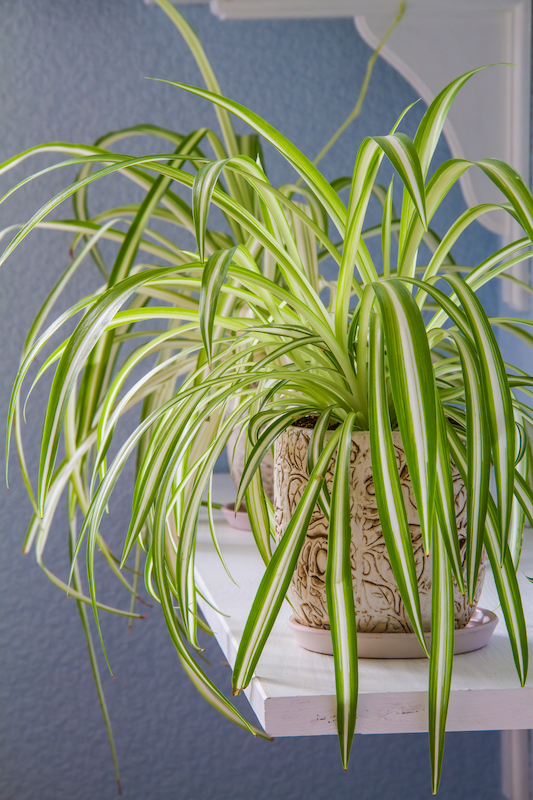
Interesting Facts
- Spider plants have been recognised by NASA as effective air purifying plants
- Spider plant varieties won’t attract spiders!
A really practical, fun and decorative plant for your home, spider plants provide a great option for a fast growing house plant in so many locations. They are a fantastic way to involve children with gardening and the different spider plant varieties available will bring a lovely bit of nature into your home.




